Global Business Environment: Analysis of SASOL Company's Strategies and Culture
VerifiedAdded on 2023/06/12
|10
|3267
|186
AI Summary
This report analyzes the importance of globalisation in strategic organisation of SASOL company and how it has influenced the decision making with the help of Hofstede's Dimensions of culture. It evaluates the strategies and culture of SASOL company using McKinsey's 7S model and discusses the ethical and sustainable factors that the company needs to consider. It also critically evaluates the strategic decision-making in relation to risk and diversification in a global context and analyzes the strategic global evaluation routes available to the SASOL company.
Contribute Materials
Your contribution can guide someone’s learning journey. Share your
documents today.
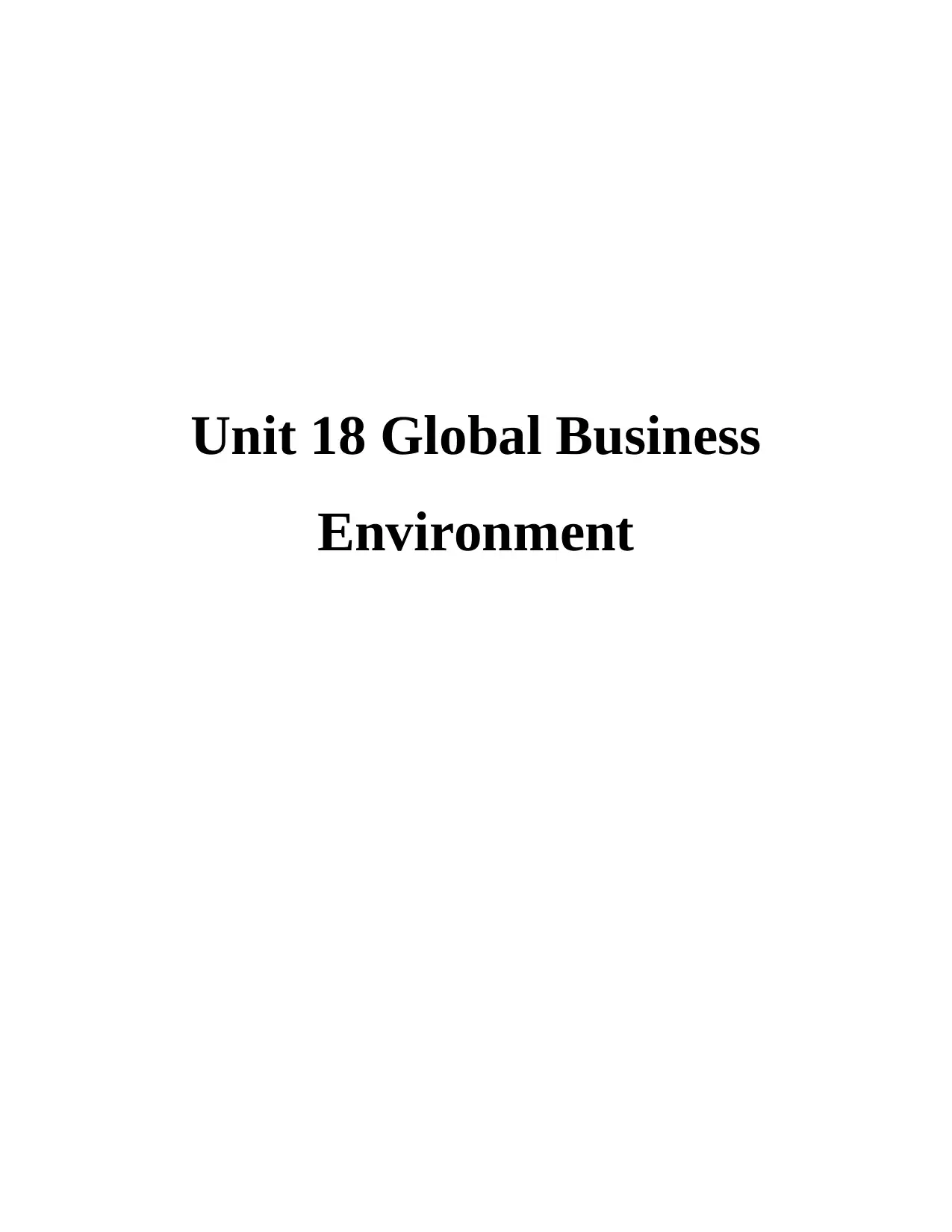
Unit 18 Global Business
Environment
Environment
Secure Best Marks with AI Grader
Need help grading? Try our AI Grader for instant feedback on your assignments.
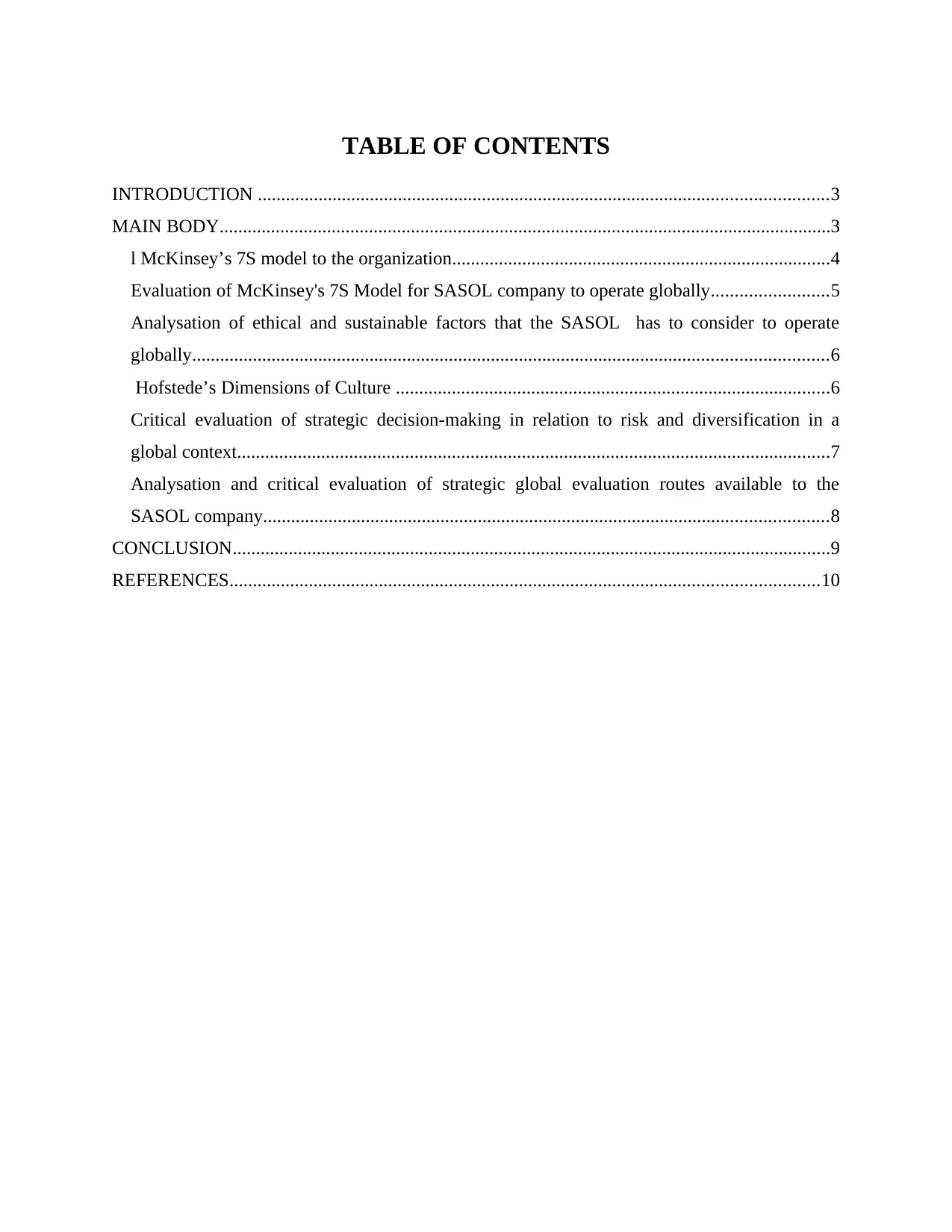
TABLE OF CONTENTS
INTRODUCTION ..........................................................................................................................3
MAIN BODY...................................................................................................................................3
l McKinsey’s 7S model to the organization.................................................................................4
Evaluation of McKinsey's 7S Model for SASOL company to operate globally.........................5
Analysation of ethical and sustainable factors that the SASOL has to consider to operate
globally........................................................................................................................................6
Hofstede’s Dimensions of Culture .............................................................................................6
Critical evaluation of strategic decision-making in relation to risk and diversification in a
global context...............................................................................................................................7
Analysation and critical evaluation of strategic global evaluation routes available to the
SASOL company.........................................................................................................................8
CONCLUSION................................................................................................................................9
REFERENCES..............................................................................................................................10
INTRODUCTION ..........................................................................................................................3
MAIN BODY...................................................................................................................................3
l McKinsey’s 7S model to the organization.................................................................................4
Evaluation of McKinsey's 7S Model for SASOL company to operate globally.........................5
Analysation of ethical and sustainable factors that the SASOL has to consider to operate
globally........................................................................................................................................6
Hofstede’s Dimensions of Culture .............................................................................................6
Critical evaluation of strategic decision-making in relation to risk and diversification in a
global context...............................................................................................................................7
Analysation and critical evaluation of strategic global evaluation routes available to the
SASOL company.........................................................................................................................8
CONCLUSION................................................................................................................................9
REFERENCES..............................................................................................................................10
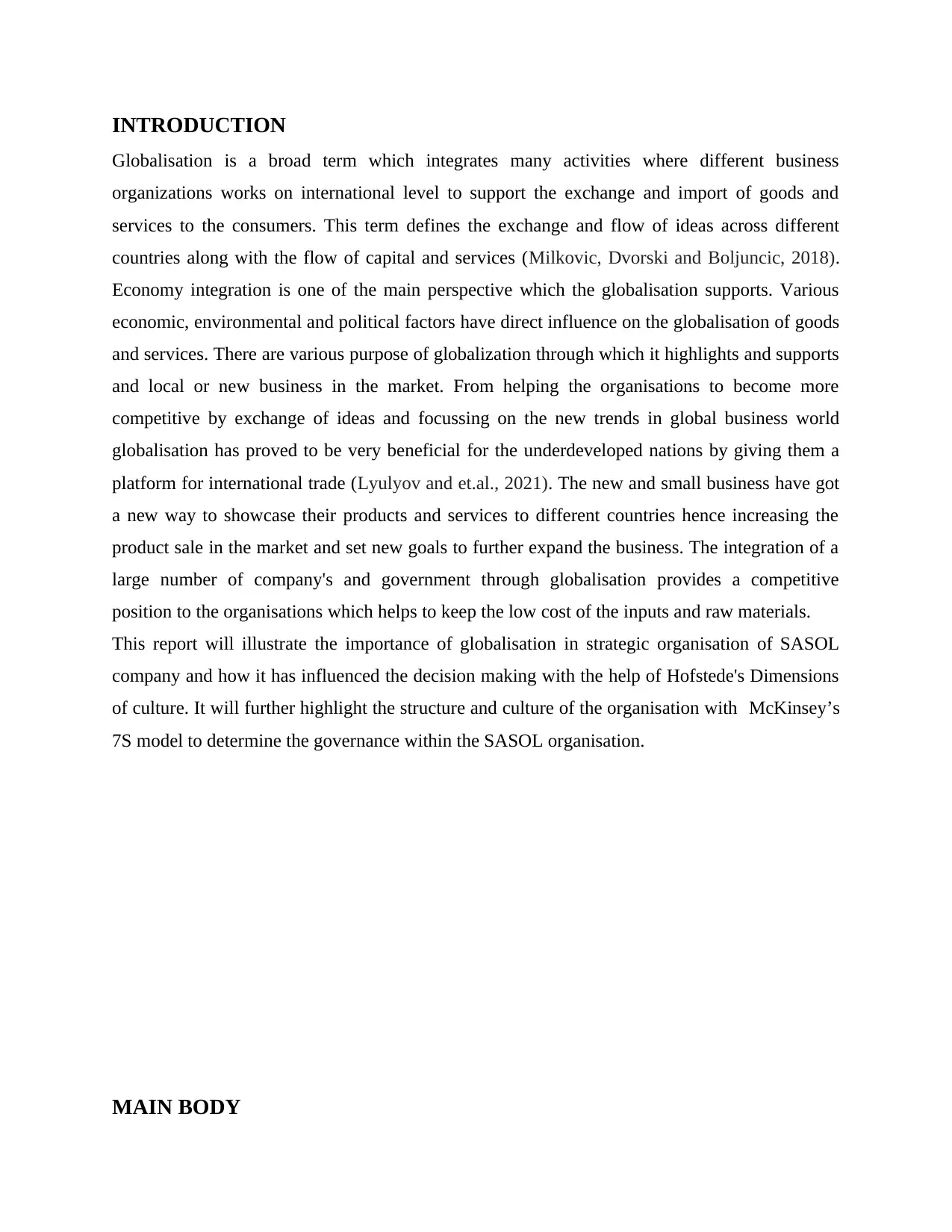
INTRODUCTION
Globalisation is a broad term which integrates many activities where different business
organizations works on international level to support the exchange and import of goods and
services to the consumers. This term defines the exchange and flow of ideas across different
countries along with the flow of capital and services (Milkovic, Dvorski and Boljuncic, 2018).
Economy integration is one of the main perspective which the globalisation supports. Various
economic, environmental and political factors have direct influence on the globalisation of goods
and services. There are various purpose of globalization through which it highlights and supports
and local or new business in the market. From helping the organisations to become more
competitive by exchange of ideas and focussing on the new trends in global business world
globalisation has proved to be very beneficial for the underdeveloped nations by giving them a
platform for international trade (Lyulyov and et.al., 2021). The new and small business have got
a new way to showcase their products and services to different countries hence increasing the
product sale in the market and set new goals to further expand the business. The integration of a
large number of company's and government through globalisation provides a competitive
position to the organisations which helps to keep the low cost of the inputs and raw materials.
This report will illustrate the importance of globalisation in strategic organisation of SASOL
company and how it has influenced the decision making with the help of Hofstede's Dimensions
of culture. It will further highlight the structure and culture of the organisation with McKinsey’s
7S model to determine the governance within the SASOL organisation.
MAIN BODY
Globalisation is a broad term which integrates many activities where different business
organizations works on international level to support the exchange and import of goods and
services to the consumers. This term defines the exchange and flow of ideas across different
countries along with the flow of capital and services (Milkovic, Dvorski and Boljuncic, 2018).
Economy integration is one of the main perspective which the globalisation supports. Various
economic, environmental and political factors have direct influence on the globalisation of goods
and services. There are various purpose of globalization through which it highlights and supports
and local or new business in the market. From helping the organisations to become more
competitive by exchange of ideas and focussing on the new trends in global business world
globalisation has proved to be very beneficial for the underdeveloped nations by giving them a
platform for international trade (Lyulyov and et.al., 2021). The new and small business have got
a new way to showcase their products and services to different countries hence increasing the
product sale in the market and set new goals to further expand the business. The integration of a
large number of company's and government through globalisation provides a competitive
position to the organisations which helps to keep the low cost of the inputs and raw materials.
This report will illustrate the importance of globalisation in strategic organisation of SASOL
company and how it has influenced the decision making with the help of Hofstede's Dimensions
of culture. It will further highlight the structure and culture of the organisation with McKinsey’s
7S model to determine the governance within the SASOL organisation.
MAIN BODY
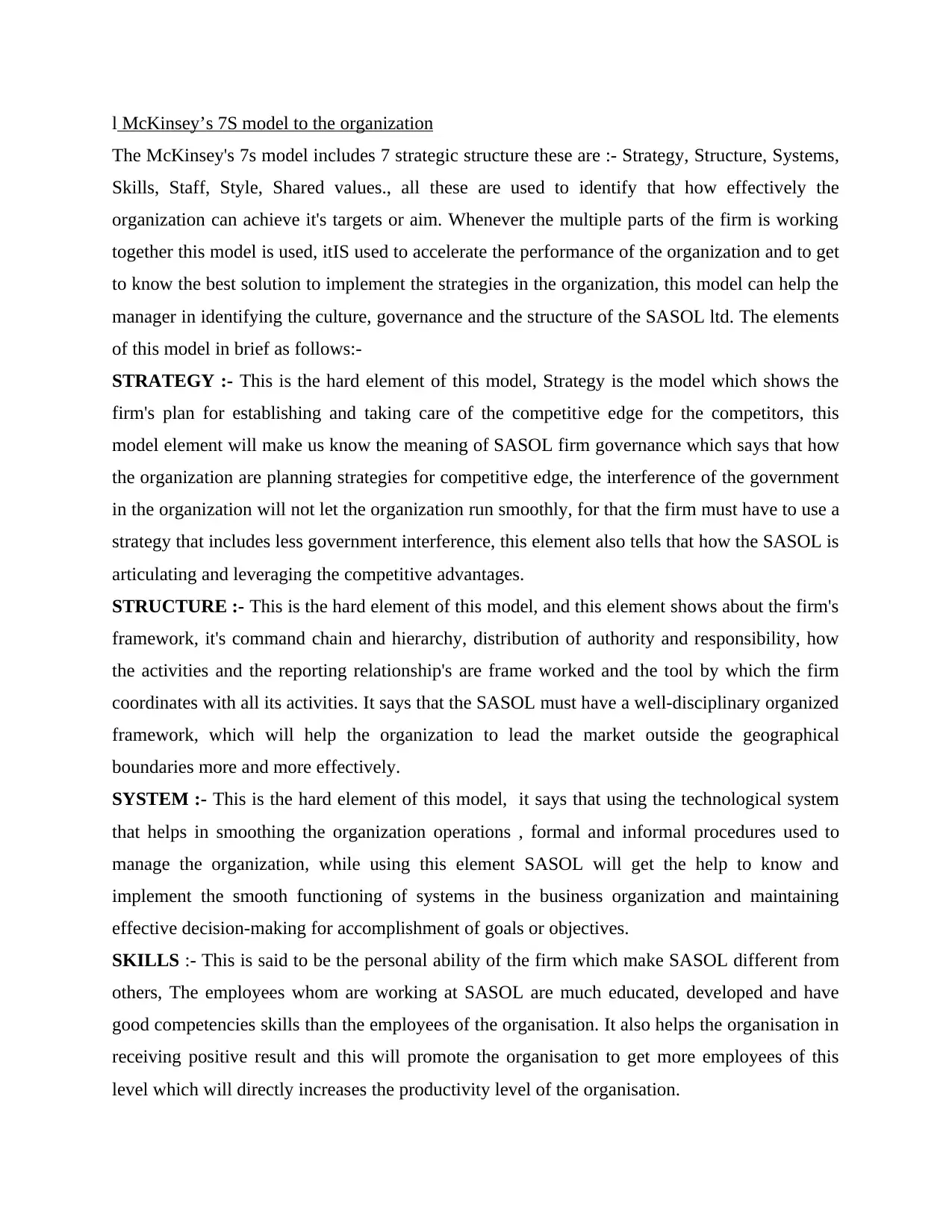
l McKinsey’s 7S model to the organization
The McKinsey's 7s model includes 7 strategic structure these are :- Strategy, Structure, Systems,
Skills, Staff, Style, Shared values., all these are used to identify that how effectively the
organization can achieve it's targets or aim. Whenever the multiple parts of the firm is working
together this model is used, itIS used to accelerate the performance of the organization and to get
to know the best solution to implement the strategies in the organization, this model can help the
manager in identifying the culture, governance and the structure of the SASOL ltd. The elements
of this model in brief as follows:-
STRATEGY :- This is the hard element of this model, Strategy is the model which shows the
firm's plan for establishing and taking care of the competitive edge for the competitors, this
model element will make us know the meaning of SASOL firm governance which says that how
the organization are planning strategies for competitive edge, the interference of the government
in the organization will not let the organization run smoothly, for that the firm must have to use a
strategy that includes less government interference, this element also tells that how the SASOL is
articulating and leveraging the competitive advantages.
STRUCTURE :- This is the hard element of this model, and this element shows about the firm's
framework, it's command chain and hierarchy, distribution of authority and responsibility, how
the activities and the reporting relationship's are frame worked and the tool by which the firm
coordinates with all its activities. It says that the SASOL must have a well-disciplinary organized
framework, which will help the organization to lead the market outside the geographical
boundaries more and more effectively.
SYSTEM :- This is the hard element of this model, it says that using the technological system
that helps in smoothing the organization operations , formal and informal procedures used to
manage the organization, while using this element SASOL will get the help to know and
implement the smooth functioning of systems in the business organization and maintaining
effective decision-making for accomplishment of goals or objectives.
SKILLS :- This is said to be the personal ability of the firm which make SASOL different from
others, The employees whom are working at SASOL are much educated, developed and have
good competencies skills than the employees of the organisation. It also helps the organisation in
receiving positive result and this will promote the organisation to get more employees of this
level which will directly increases the productivity level of the organisation.
The McKinsey's 7s model includes 7 strategic structure these are :- Strategy, Structure, Systems,
Skills, Staff, Style, Shared values., all these are used to identify that how effectively the
organization can achieve it's targets or aim. Whenever the multiple parts of the firm is working
together this model is used, itIS used to accelerate the performance of the organization and to get
to know the best solution to implement the strategies in the organization, this model can help the
manager in identifying the culture, governance and the structure of the SASOL ltd. The elements
of this model in brief as follows:-
STRATEGY :- This is the hard element of this model, Strategy is the model which shows the
firm's plan for establishing and taking care of the competitive edge for the competitors, this
model element will make us know the meaning of SASOL firm governance which says that how
the organization are planning strategies for competitive edge, the interference of the government
in the organization will not let the organization run smoothly, for that the firm must have to use a
strategy that includes less government interference, this element also tells that how the SASOL is
articulating and leveraging the competitive advantages.
STRUCTURE :- This is the hard element of this model, and this element shows about the firm's
framework, it's command chain and hierarchy, distribution of authority and responsibility, how
the activities and the reporting relationship's are frame worked and the tool by which the firm
coordinates with all its activities. It says that the SASOL must have a well-disciplinary organized
framework, which will help the organization to lead the market outside the geographical
boundaries more and more effectively.
SYSTEM :- This is the hard element of this model, it says that using the technological system
that helps in smoothing the organization operations , formal and informal procedures used to
manage the organization, while using this element SASOL will get the help to know and
implement the smooth functioning of systems in the business organization and maintaining
effective decision-making for accomplishment of goals or objectives.
SKILLS :- This is said to be the personal ability of the firm which make SASOL different from
others, The employees whom are working at SASOL are much educated, developed and have
good competencies skills than the employees of the organisation. It also helps the organisation in
receiving positive result and this will promote the organisation to get more employees of this
level which will directly increases the productivity level of the organisation.
Secure Best Marks with AI Grader
Need help grading? Try our AI Grader for instant feedback on your assignments.
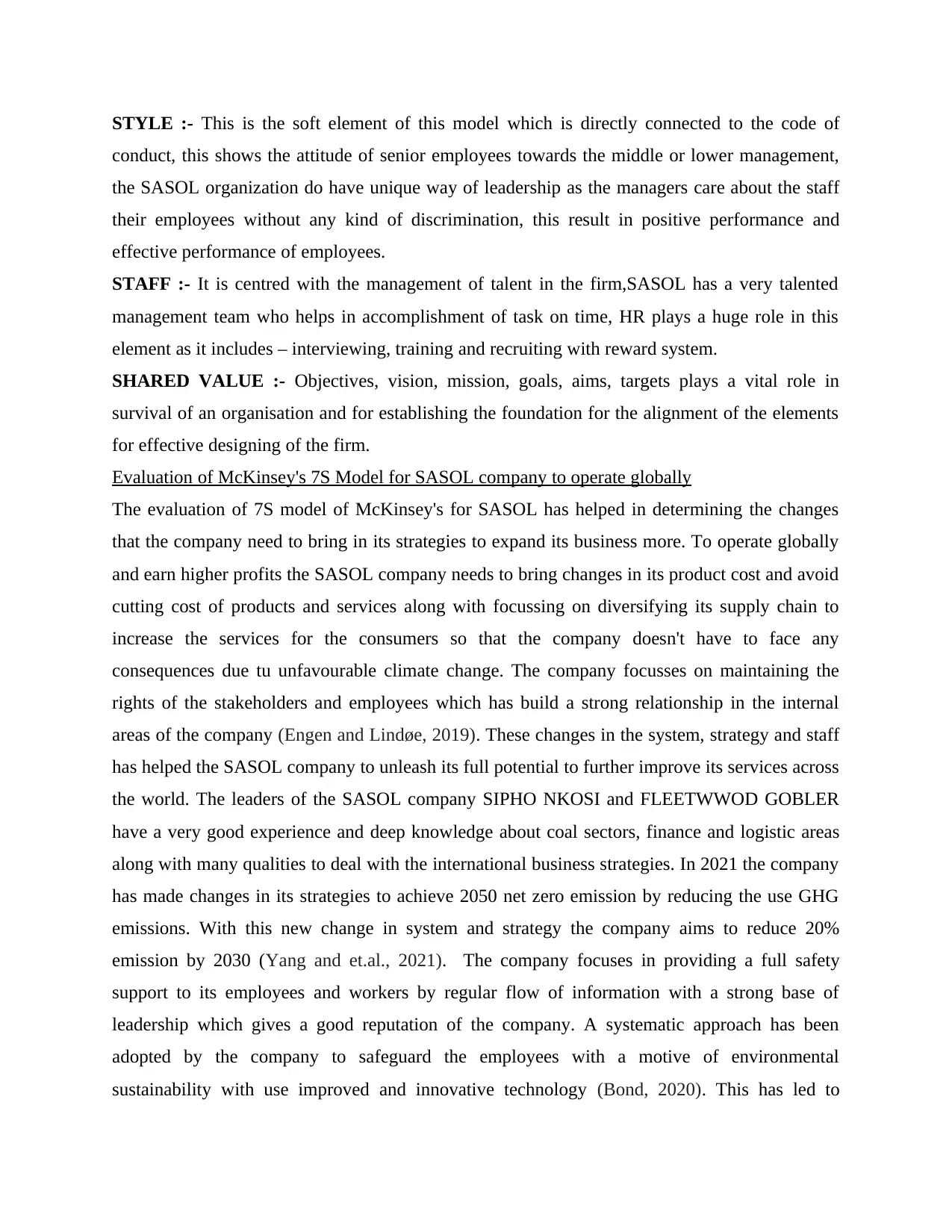
STYLE :- This is the soft element of this model which is directly connected to the code of
conduct, this shows the attitude of senior employees towards the middle or lower management,
the SASOL organization do have unique way of leadership as the managers care about the staff
their employees without any kind of discrimination, this result in positive performance and
effective performance of employees.
STAFF :- It is centred with the management of talent in the firm,SASOL has a very talented
management team who helps in accomplishment of task on time, HR plays a huge role in this
element as it includes – interviewing, training and recruiting with reward system.
SHARED VALUE :- Objectives, vision, mission, goals, aims, targets plays a vital role in
survival of an organisation and for establishing the foundation for the alignment of the elements
for effective designing of the firm.
Evaluation of McKinsey's 7S Model for SASOL company to operate globally
The evaluation of 7S model of McKinsey's for SASOL has helped in determining the changes
that the company need to bring in its strategies to expand its business more. To operate globally
and earn higher profits the SASOL company needs to bring changes in its product cost and avoid
cutting cost of products and services along with focussing on diversifying its supply chain to
increase the services for the consumers so that the company doesn't have to face any
consequences due tu unfavourable climate change. The company focusses on maintaining the
rights of the stakeholders and employees which has build a strong relationship in the internal
areas of the company (Engen and Lindøe, 2019). These changes in the system, strategy and staff
has helped the SASOL company to unleash its full potential to further improve its services across
the world. The leaders of the SASOL company SIPHO NKOSI and FLEETWWOD GOBLER
have a very good experience and deep knowledge about coal sectors, finance and logistic areas
along with many qualities to deal with the international business strategies. In 2021 the company
has made changes in its strategies to achieve 2050 net zero emission by reducing the use GHG
emissions. With this new change in system and strategy the company aims to reduce 20%
emission by 2030 (Yang and et.al., 2021). The company focuses in providing a full safety
support to its employees and workers by regular flow of information with a strong base of
leadership which gives a good reputation of the company. A systematic approach has been
adopted by the company to safeguard the employees with a motive of environmental
sustainability with use improved and innovative technology (Bond, 2020). This has led to
conduct, this shows the attitude of senior employees towards the middle or lower management,
the SASOL organization do have unique way of leadership as the managers care about the staff
their employees without any kind of discrimination, this result in positive performance and
effective performance of employees.
STAFF :- It is centred with the management of talent in the firm,SASOL has a very talented
management team who helps in accomplishment of task on time, HR plays a huge role in this
element as it includes – interviewing, training and recruiting with reward system.
SHARED VALUE :- Objectives, vision, mission, goals, aims, targets plays a vital role in
survival of an organisation and for establishing the foundation for the alignment of the elements
for effective designing of the firm.
Evaluation of McKinsey's 7S Model for SASOL company to operate globally
The evaluation of 7S model of McKinsey's for SASOL has helped in determining the changes
that the company need to bring in its strategies to expand its business more. To operate globally
and earn higher profits the SASOL company needs to bring changes in its product cost and avoid
cutting cost of products and services along with focussing on diversifying its supply chain to
increase the services for the consumers so that the company doesn't have to face any
consequences due tu unfavourable climate change. The company focusses on maintaining the
rights of the stakeholders and employees which has build a strong relationship in the internal
areas of the company (Engen and Lindøe, 2019). These changes in the system, strategy and staff
has helped the SASOL company to unleash its full potential to further improve its services across
the world. The leaders of the SASOL company SIPHO NKOSI and FLEETWWOD GOBLER
have a very good experience and deep knowledge about coal sectors, finance and logistic areas
along with many qualities to deal with the international business strategies. In 2021 the company
has made changes in its strategies to achieve 2050 net zero emission by reducing the use GHG
emissions. With this new change in system and strategy the company aims to reduce 20%
emission by 2030 (Yang and et.al., 2021). The company focuses in providing a full safety
support to its employees and workers by regular flow of information with a strong base of
leadership which gives a good reputation of the company. A systematic approach has been
adopted by the company to safeguard the employees with a motive of environmental
sustainability with use improved and innovative technology (Bond, 2020). This has led to
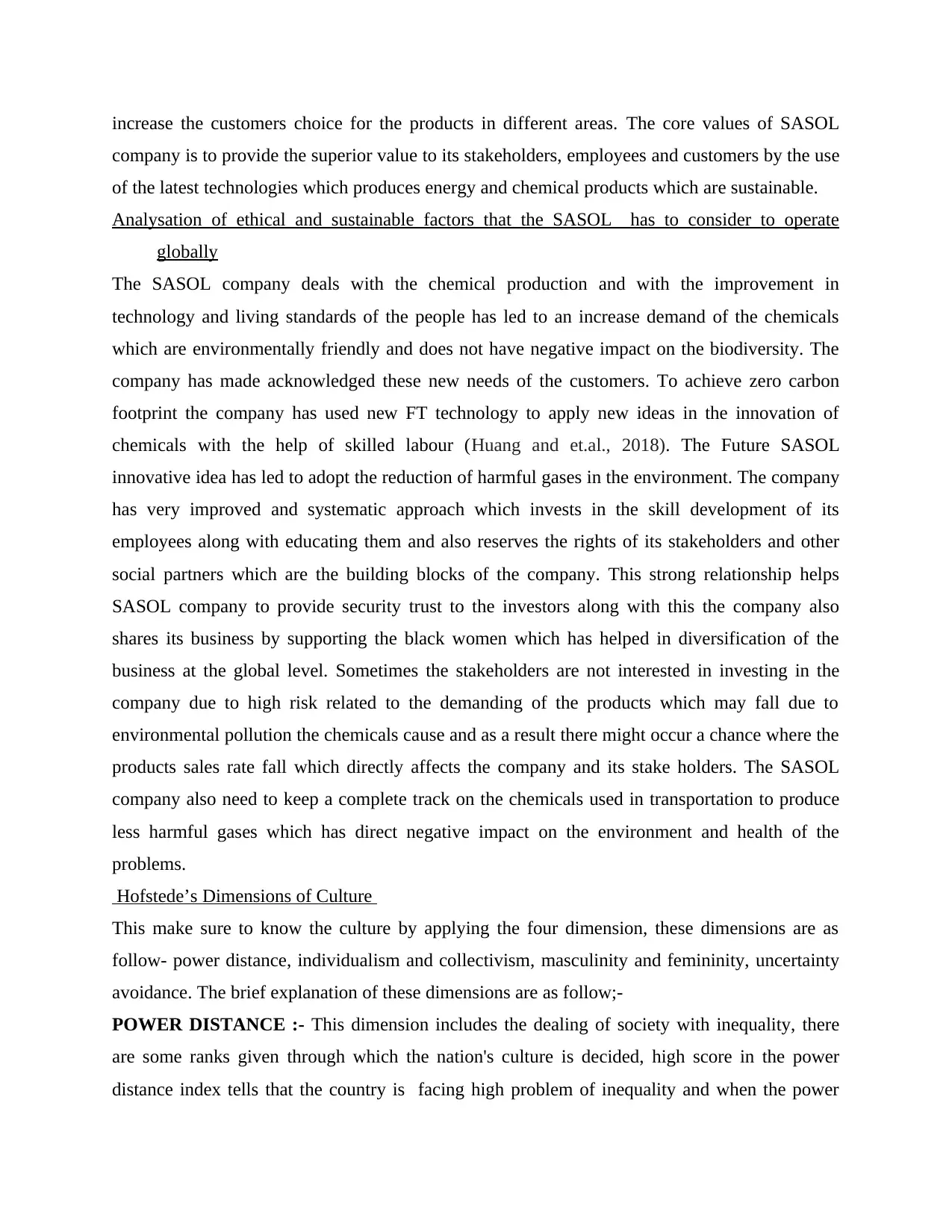
increase the customers choice for the products in different areas. The core values of SASOL
company is to provide the superior value to its stakeholders, employees and customers by the use
of the latest technologies which produces energy and chemical products which are sustainable.
Analysation of ethical and sustainable factors that the SASOL has to consider to operate
globally
The SASOL company deals with the chemical production and with the improvement in
technology and living standards of the people has led to an increase demand of the chemicals
which are environmentally friendly and does not have negative impact on the biodiversity. The
company has made acknowledged these new needs of the customers. To achieve zero carbon
footprint the company has used new FT technology to apply new ideas in the innovation of
chemicals with the help of skilled labour (Huang and et.al., 2018). The Future SASOL
innovative idea has led to adopt the reduction of harmful gases in the environment. The company
has very improved and systematic approach which invests in the skill development of its
employees along with educating them and also reserves the rights of its stakeholders and other
social partners which are the building blocks of the company. This strong relationship helps
SASOL company to provide security trust to the investors along with this the company also
shares its business by supporting the black women which has helped in diversification of the
business at the global level. Sometimes the stakeholders are not interested in investing in the
company due to high risk related to the demanding of the products which may fall due to
environmental pollution the chemicals cause and as a result there might occur a chance where the
products sales rate fall which directly affects the company and its stake holders. The SASOL
company also need to keep a complete track on the chemicals used in transportation to produce
less harmful gases which has direct negative impact on the environment and health of the
problems.
Hofstede’s Dimensions of Culture
This make sure to know the culture by applying the four dimension, these dimensions are as
follow- power distance, individualism and collectivism, masculinity and femininity, uncertainty
avoidance. The brief explanation of these dimensions are as follow;-
POWER DISTANCE :- This dimension includes the dealing of society with inequality, there
are some ranks given through which the nation's culture is decided, high score in the power
distance index tells that the country is facing high problem of inequality and when the power
company is to provide the superior value to its stakeholders, employees and customers by the use
of the latest technologies which produces energy and chemical products which are sustainable.
Analysation of ethical and sustainable factors that the SASOL has to consider to operate
globally
The SASOL company deals with the chemical production and with the improvement in
technology and living standards of the people has led to an increase demand of the chemicals
which are environmentally friendly and does not have negative impact on the biodiversity. The
company has made acknowledged these new needs of the customers. To achieve zero carbon
footprint the company has used new FT technology to apply new ideas in the innovation of
chemicals with the help of skilled labour (Huang and et.al., 2018). The Future SASOL
innovative idea has led to adopt the reduction of harmful gases in the environment. The company
has very improved and systematic approach which invests in the skill development of its
employees along with educating them and also reserves the rights of its stakeholders and other
social partners which are the building blocks of the company. This strong relationship helps
SASOL company to provide security trust to the investors along with this the company also
shares its business by supporting the black women which has helped in diversification of the
business at the global level. Sometimes the stakeholders are not interested in investing in the
company due to high risk related to the demanding of the products which may fall due to
environmental pollution the chemicals cause and as a result there might occur a chance where the
products sales rate fall which directly affects the company and its stake holders. The SASOL
company also need to keep a complete track on the chemicals used in transportation to produce
less harmful gases which has direct negative impact on the environment and health of the
problems.
Hofstede’s Dimensions of Culture
This make sure to know the culture by applying the four dimension, these dimensions are as
follow- power distance, individualism and collectivism, masculinity and femininity, uncertainty
avoidance. The brief explanation of these dimensions are as follow;-
POWER DISTANCE :- This dimension includes the dealing of society with inequality, there
are some ranks given through which the nation's culture is decided, high score in the power
distance index tells that the country is facing high problem of inequality and when the power
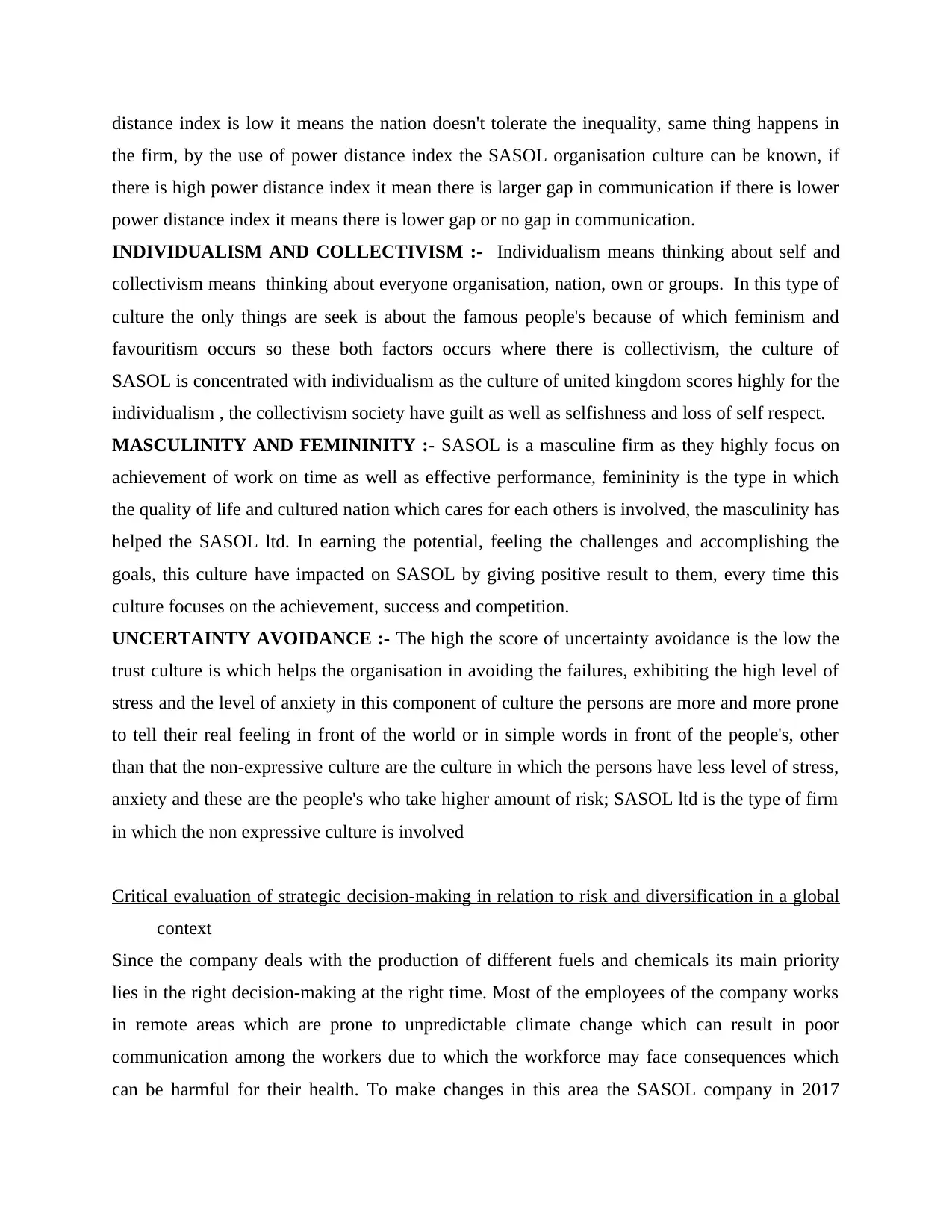
distance index is low it means the nation doesn't tolerate the inequality, same thing happens in
the firm, by the use of power distance index the SASOL organisation culture can be known, if
there is high power distance index it mean there is larger gap in communication if there is lower
power distance index it means there is lower gap or no gap in communication.
INDIVIDUALISM AND COLLECTIVISM :- Individualism means thinking about self and
collectivism means thinking about everyone organisation, nation, own or groups. In this type of
culture the only things are seek is about the famous people's because of which feminism and
favouritism occurs so these both factors occurs where there is collectivism, the culture of
SASOL is concentrated with individualism as the culture of united kingdom scores highly for the
individualism , the collectivism society have guilt as well as selfishness and loss of self respect.
MASCULINITY AND FEMININITY :- SASOL is a masculine firm as they highly focus on
achievement of work on time as well as effective performance, femininity is the type in which
the quality of life and cultured nation which cares for each others is involved, the masculinity has
helped the SASOL ltd. In earning the potential, feeling the challenges and accomplishing the
goals, this culture have impacted on SASOL by giving positive result to them, every time this
culture focuses on the achievement, success and competition.
UNCERTAINTY AVOIDANCE :- The high the score of uncertainty avoidance is the low the
trust culture is which helps the organisation in avoiding the failures, exhibiting the high level of
stress and the level of anxiety in this component of culture the persons are more and more prone
to tell their real feeling in front of the world or in simple words in front of the people's, other
than that the non-expressive culture are the culture in which the persons have less level of stress,
anxiety and these are the people's who take higher amount of risk; SASOL ltd is the type of firm
in which the non expressive culture is involved
Critical evaluation of strategic decision-making in relation to risk and diversification in a global
context
Since the company deals with the production of different fuels and chemicals its main priority
lies in the right decision-making at the right time. Most of the employees of the company works
in remote areas which are prone to unpredictable climate change which can result in poor
communication among the workers due to which the workforce may face consequences which
can be harmful for their health. To make changes in this area the SASOL company in 2017
the firm, by the use of power distance index the SASOL organisation culture can be known, if
there is high power distance index it mean there is larger gap in communication if there is lower
power distance index it means there is lower gap or no gap in communication.
INDIVIDUALISM AND COLLECTIVISM :- Individualism means thinking about self and
collectivism means thinking about everyone organisation, nation, own or groups. In this type of
culture the only things are seek is about the famous people's because of which feminism and
favouritism occurs so these both factors occurs where there is collectivism, the culture of
SASOL is concentrated with individualism as the culture of united kingdom scores highly for the
individualism , the collectivism society have guilt as well as selfishness and loss of self respect.
MASCULINITY AND FEMININITY :- SASOL is a masculine firm as they highly focus on
achievement of work on time as well as effective performance, femininity is the type in which
the quality of life and cultured nation which cares for each others is involved, the masculinity has
helped the SASOL ltd. In earning the potential, feeling the challenges and accomplishing the
goals, this culture have impacted on SASOL by giving positive result to them, every time this
culture focuses on the achievement, success and competition.
UNCERTAINTY AVOIDANCE :- The high the score of uncertainty avoidance is the low the
trust culture is which helps the organisation in avoiding the failures, exhibiting the high level of
stress and the level of anxiety in this component of culture the persons are more and more prone
to tell their real feeling in front of the world or in simple words in front of the people's, other
than that the non-expressive culture are the culture in which the persons have less level of stress,
anxiety and these are the people's who take higher amount of risk; SASOL ltd is the type of firm
in which the non expressive culture is involved
Critical evaluation of strategic decision-making in relation to risk and diversification in a global
context
Since the company deals with the production of different fuels and chemicals its main priority
lies in the right decision-making at the right time. Most of the employees of the company works
in remote areas which are prone to unpredictable climate change which can result in poor
communication among the workers due to which the workforce may face consequences which
can be harmful for their health. To make changes in this area the SASOL company in 2017
Paraphrase This Document
Need a fresh take? Get an instant paraphrase of this document with our AI Paraphraser
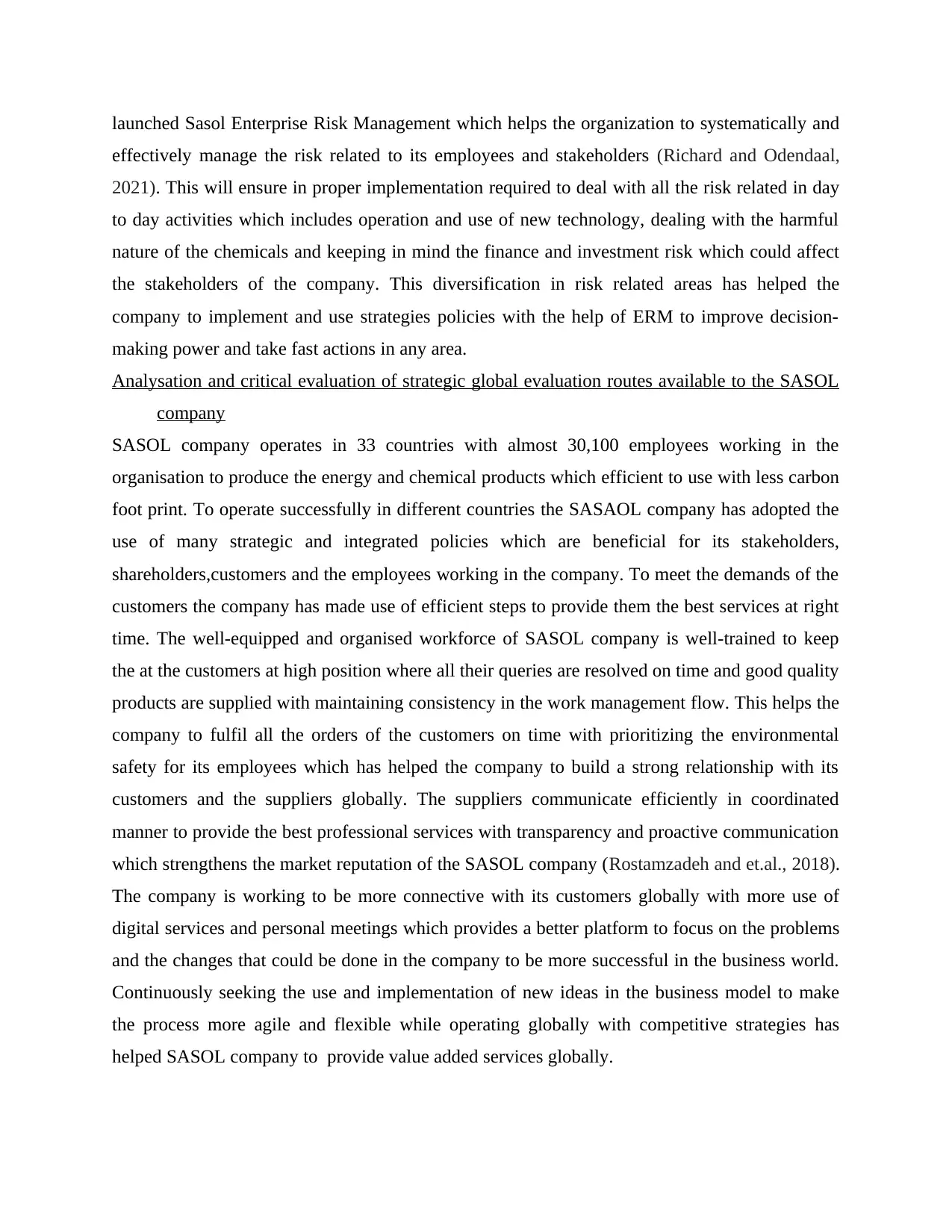
launched Sasol Enterprise Risk Management which helps the organization to systematically and
effectively manage the risk related to its employees and stakeholders (Richard and Odendaal,
2021). This will ensure in proper implementation required to deal with all the risk related in day
to day activities which includes operation and use of new technology, dealing with the harmful
nature of the chemicals and keeping in mind the finance and investment risk which could affect
the stakeholders of the company. This diversification in risk related areas has helped the
company to implement and use strategies policies with the help of ERM to improve decision-
making power and take fast actions in any area.
Analysation and critical evaluation of strategic global evaluation routes available to the SASOL
company
SASOL company operates in 33 countries with almost 30,100 employees working in the
organisation to produce the energy and chemical products which efficient to use with less carbon
foot print. To operate successfully in different countries the SASAOL company has adopted the
use of many strategic and integrated policies which are beneficial for its stakeholders,
shareholders,customers and the employees working in the company. To meet the demands of the
customers the company has made use of efficient steps to provide them the best services at right
time. The well-equipped and organised workforce of SASOL company is well-trained to keep
the at the customers at high position where all their queries are resolved on time and good quality
products are supplied with maintaining consistency in the work management flow. This helps the
company to fulfil all the orders of the customers on time with prioritizing the environmental
safety for its employees which has helped the company to build a strong relationship with its
customers and the suppliers globally. The suppliers communicate efficiently in coordinated
manner to provide the best professional services with transparency and proactive communication
which strengthens the market reputation of the SASOL company (Rostamzadeh and et.al., 2018).
The company is working to be more connective with its customers globally with more use of
digital services and personal meetings which provides a better platform to focus on the problems
and the changes that could be done in the company to be more successful in the business world.
Continuously seeking the use and implementation of new ideas in the business model to make
the process more agile and flexible while operating globally with competitive strategies has
helped SASOL company to provide value added services globally.
effectively manage the risk related to its employees and stakeholders (Richard and Odendaal,
2021). This will ensure in proper implementation required to deal with all the risk related in day
to day activities which includes operation and use of new technology, dealing with the harmful
nature of the chemicals and keeping in mind the finance and investment risk which could affect
the stakeholders of the company. This diversification in risk related areas has helped the
company to implement and use strategies policies with the help of ERM to improve decision-
making power and take fast actions in any area.
Analysation and critical evaluation of strategic global evaluation routes available to the SASOL
company
SASOL company operates in 33 countries with almost 30,100 employees working in the
organisation to produce the energy and chemical products which efficient to use with less carbon
foot print. To operate successfully in different countries the SASAOL company has adopted the
use of many strategic and integrated policies which are beneficial for its stakeholders,
shareholders,customers and the employees working in the company. To meet the demands of the
customers the company has made use of efficient steps to provide them the best services at right
time. The well-equipped and organised workforce of SASOL company is well-trained to keep
the at the customers at high position where all their queries are resolved on time and good quality
products are supplied with maintaining consistency in the work management flow. This helps the
company to fulfil all the orders of the customers on time with prioritizing the environmental
safety for its employees which has helped the company to build a strong relationship with its
customers and the suppliers globally. The suppliers communicate efficiently in coordinated
manner to provide the best professional services with transparency and proactive communication
which strengthens the market reputation of the SASOL company (Rostamzadeh and et.al., 2018).
The company is working to be more connective with its customers globally with more use of
digital services and personal meetings which provides a better platform to focus on the problems
and the changes that could be done in the company to be more successful in the business world.
Continuously seeking the use and implementation of new ideas in the business model to make
the process more agile and flexible while operating globally with competitive strategies has
helped SASOL company to provide value added services globally.
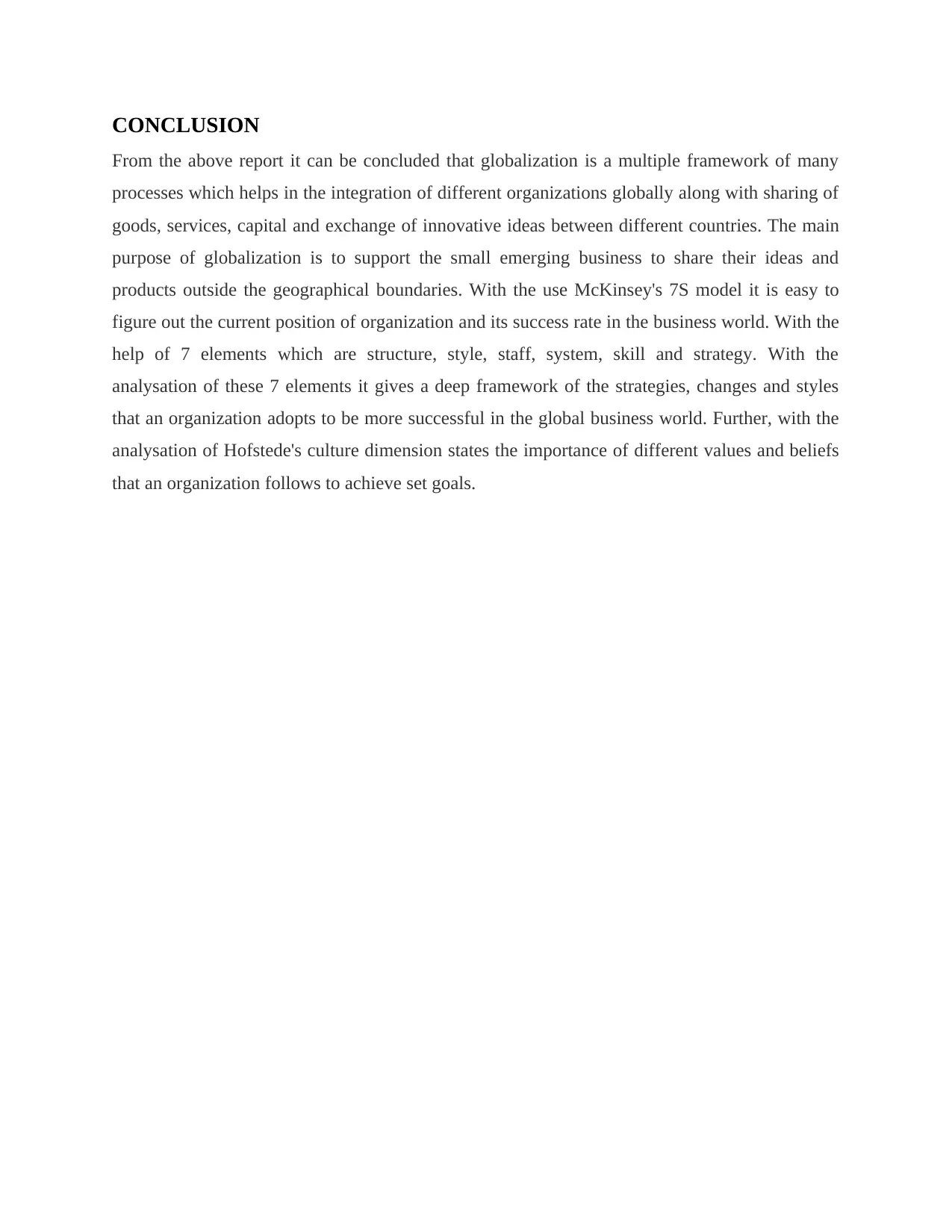
CONCLUSION
From the above report it can be concluded that globalization is a multiple framework of many
processes which helps in the integration of different organizations globally along with sharing of
goods, services, capital and exchange of innovative ideas between different countries. The main
purpose of globalization is to support the small emerging business to share their ideas and
products outside the geographical boundaries. With the use McKinsey's 7S model it is easy to
figure out the current position of organization and its success rate in the business world. With the
help of 7 elements which are structure, style, staff, system, skill and strategy. With the
analysation of these 7 elements it gives a deep framework of the strategies, changes and styles
that an organization adopts to be more successful in the global business world. Further, with the
analysation of Hofstede's culture dimension states the importance of different values and beliefs
that an organization follows to achieve set goals.
From the above report it can be concluded that globalization is a multiple framework of many
processes which helps in the integration of different organizations globally along with sharing of
goods, services, capital and exchange of innovative ideas between different countries. The main
purpose of globalization is to support the small emerging business to share their ideas and
products outside the geographical boundaries. With the use McKinsey's 7S model it is easy to
figure out the current position of organization and its success rate in the business world. With the
help of 7 elements which are structure, style, staff, system, skill and strategy. With the
analysation of these 7 elements it gives a deep framework of the strategies, changes and styles
that an organization adopts to be more successful in the global business world. Further, with the
analysation of Hofstede's culture dimension states the importance of different values and beliefs
that an organization follows to achieve set goals.
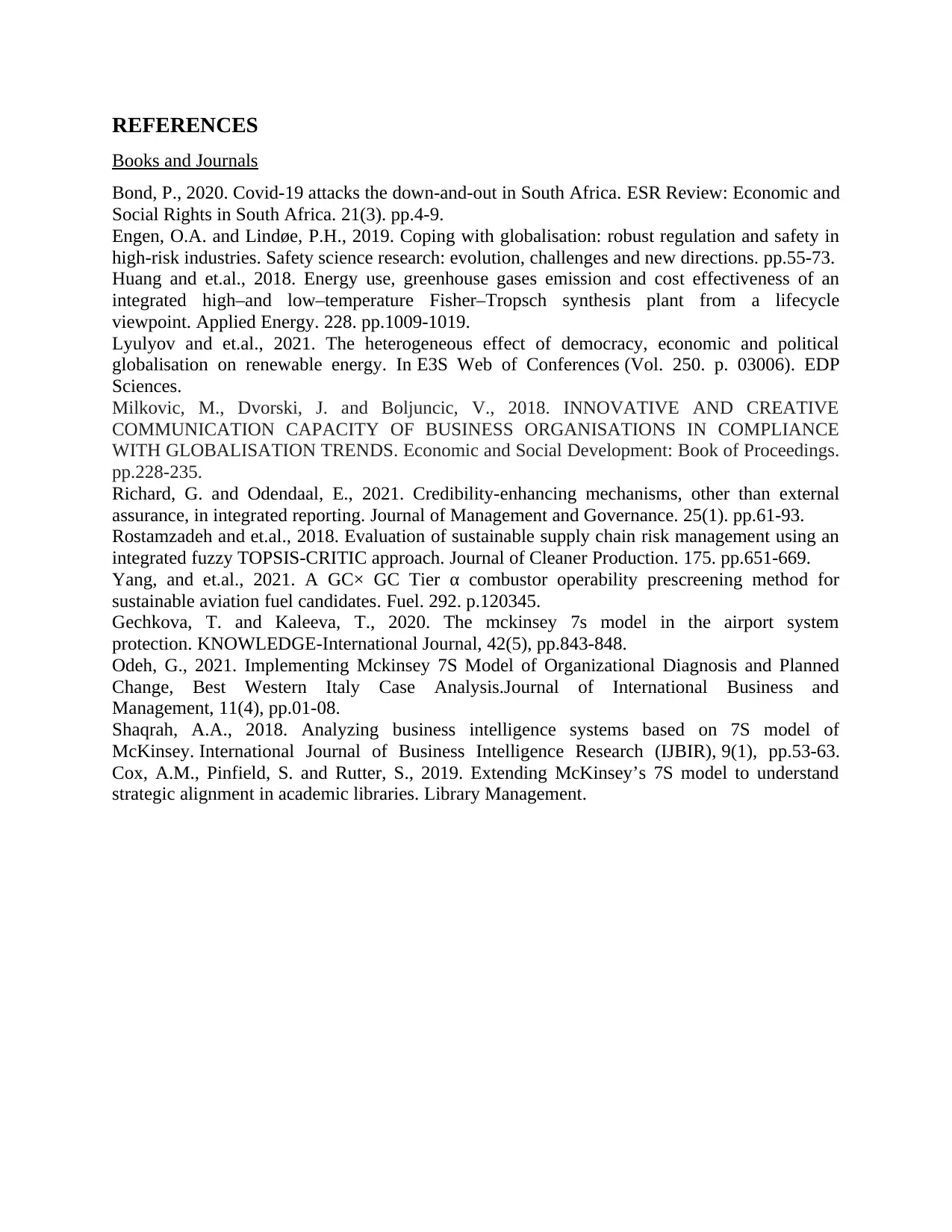
REFERENCES
Books and Journals
Bond, P., 2020. Covid-19 attacks the down-and-out in South Africa. ESR Review: Economic and
Social Rights in South Africa. 21(3). pp.4-9.
Engen, O.A. and Lindøe, P.H., 2019. Coping with globalisation: robust regulation and safety in
high-risk industries. Safety science research: evolution, challenges and new directions. pp.55-73.
Huang and et.al., 2018. Energy use, greenhouse gases emission and cost effectiveness of an
integrated high–and low–temperature Fisher–Tropsch synthesis plant from a lifecycle
viewpoint. Applied Energy. 228. pp.1009-1019.
Lyulyov and et.al., 2021. The heterogeneous effect of democracy, economic and political
globalisation on renewable energy. In E3S Web of Conferences (Vol. 250. p. 03006). EDP
Sciences.
Milkovic, M., Dvorski, J. and Boljuncic, V., 2018. INNOVATIVE AND CREATIVE
COMMUNICATION CAPACITY OF BUSINESS ORGANISATIONS IN COMPLIANCE
WITH GLOBALISATION TRENDS. Economic and Social Development: Book of Proceedings.
pp.228-235.
Richard, G. and Odendaal, E., 2021. Credibility-enhancing mechanisms, other than external
assurance, in integrated reporting. Journal of Management and Governance. 25(1). pp.61-93.
Rostamzadeh and et.al., 2018. Evaluation of sustainable supply chain risk management using an
integrated fuzzy TOPSIS-CRITIC approach. Journal of Cleaner Production. 175. pp.651-669.
Yang, and et.al., 2021. A GC× GC Tier α combustor operability prescreening method for
sustainable aviation fuel candidates. Fuel. 292. p.120345.
Gechkova, T. and Kaleeva, T., 2020. The mckinsey 7s model in the airport system
protection. KNOWLEDGE-International Journal, 42(5), pp.843-848.
Odeh, G., 2021. Implementing Mckinsey 7S Model of Organizational Diagnosis and Planned
Change, Best Western Italy Case Analysis.Journal of International Business and
Management, 11(4), pp.01-08.
Shaqrah, A.A., 2018. Analyzing business intelligence systems based on 7S model of
McKinsey. International Journal of Business Intelligence Research (IJBIR), 9(1), pp.53-63.
Cox, A.M., Pinfield, S. and Rutter, S., 2019. Extending McKinsey’s 7S model to understand
strategic alignment in academic libraries. Library Management.
Books and Journals
Bond, P., 2020. Covid-19 attacks the down-and-out in South Africa. ESR Review: Economic and
Social Rights in South Africa. 21(3). pp.4-9.
Engen, O.A. and Lindøe, P.H., 2019. Coping with globalisation: robust regulation and safety in
high-risk industries. Safety science research: evolution, challenges and new directions. pp.55-73.
Huang and et.al., 2018. Energy use, greenhouse gases emission and cost effectiveness of an
integrated high–and low–temperature Fisher–Tropsch synthesis plant from a lifecycle
viewpoint. Applied Energy. 228. pp.1009-1019.
Lyulyov and et.al., 2021. The heterogeneous effect of democracy, economic and political
globalisation on renewable energy. In E3S Web of Conferences (Vol. 250. p. 03006). EDP
Sciences.
Milkovic, M., Dvorski, J. and Boljuncic, V., 2018. INNOVATIVE AND CREATIVE
COMMUNICATION CAPACITY OF BUSINESS ORGANISATIONS IN COMPLIANCE
WITH GLOBALISATION TRENDS. Economic and Social Development: Book of Proceedings.
pp.228-235.
Richard, G. and Odendaal, E., 2021. Credibility-enhancing mechanisms, other than external
assurance, in integrated reporting. Journal of Management and Governance. 25(1). pp.61-93.
Rostamzadeh and et.al., 2018. Evaluation of sustainable supply chain risk management using an
integrated fuzzy TOPSIS-CRITIC approach. Journal of Cleaner Production. 175. pp.651-669.
Yang, and et.al., 2021. A GC× GC Tier α combustor operability prescreening method for
sustainable aviation fuel candidates. Fuel. 292. p.120345.
Gechkova, T. and Kaleeva, T., 2020. The mckinsey 7s model in the airport system
protection. KNOWLEDGE-International Journal, 42(5), pp.843-848.
Odeh, G., 2021. Implementing Mckinsey 7S Model of Organizational Diagnosis and Planned
Change, Best Western Italy Case Analysis.Journal of International Business and
Management, 11(4), pp.01-08.
Shaqrah, A.A., 2018. Analyzing business intelligence systems based on 7S model of
McKinsey. International Journal of Business Intelligence Research (IJBIR), 9(1), pp.53-63.
Cox, A.M., Pinfield, S. and Rutter, S., 2019. Extending McKinsey’s 7S model to understand
strategic alignment in academic libraries. Library Management.
1 out of 10
Related Documents
Your All-in-One AI-Powered Toolkit for Academic Success.
+13062052269
info@desklib.com
Available 24*7 on WhatsApp / Email
![[object Object]](/_next/static/media/star-bottom.7253800d.svg)
Unlock your academic potential
© 2024 | Zucol Services PVT LTD | All rights reserved.

